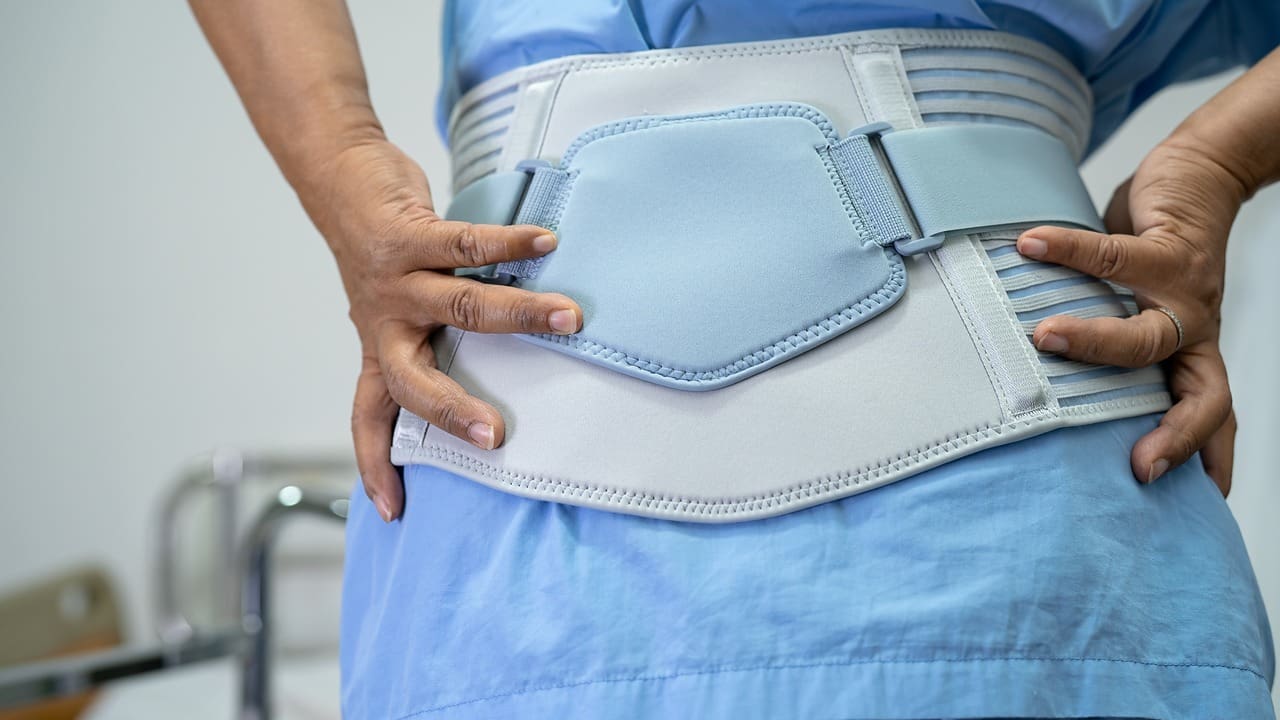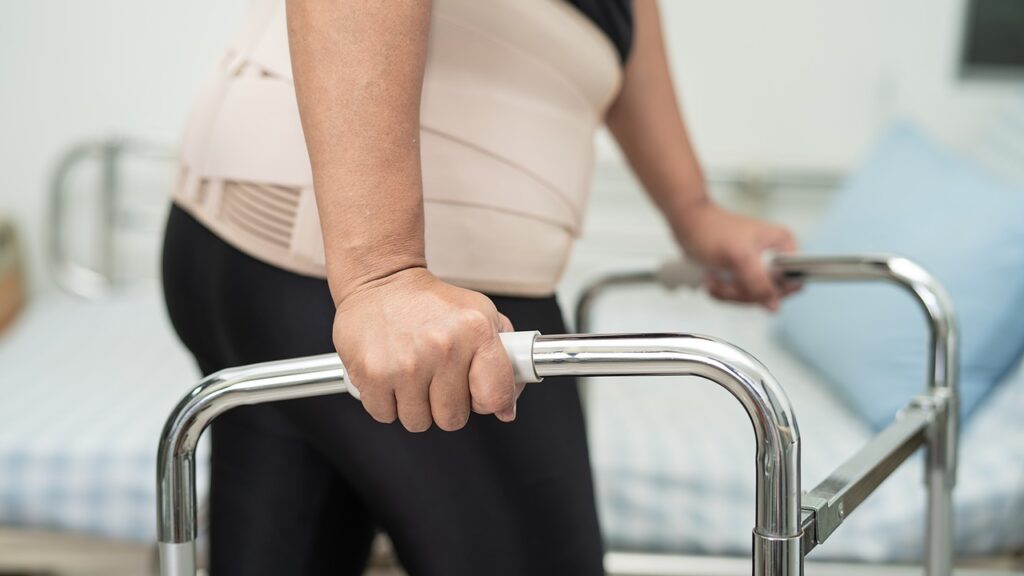Last Updated on November 4, 2025 by mcelik

Choosing to have lumbar spinal fusion surgery is a big step. Knowing what to expect during recovery is key. At Liv Hospital, we help guide you through the healing process after surgery.
Most patients stay in the hospital for 2 to 4 days. They can start with light activities in 4 to 6 weeks. It usually takes 6 to 12 months for the bones to fully heal.
The journey to recovery after lumbar surgery has many stages. From the hospital stay to when the bones heal fully. We aim to give you all the info you need to get ready for your recovery journey.

It’s important for patients to understand back fusion surgery to navigate their recovery well. This surgery, also known as spinal fusion, joins two or more vertebrae together. This helps stabilize the spine.
There are different types of spinal fusion surgeries. Lumbar fusion surgery is one of the most common. It focuses on the lower back.
Lumbar fusion surgery aims to reduce pain and stabilize the spine. It can fuse different parts of the lumbar spine.
Fusions at L5-S1 and L4-L5 are common due to degeneration and herniation. Recovery times vary based on the fusion’s level and complexity.
The recovery time for back fusion surgery can be several months to over a year. This depends on the individual’s health and the surgery’s extent.
Several factors can influence recovery time. These include age, overall health, and whether the fusion is single or multiple levels.
Older patients or those with health issues may take longer to recover. This is because they may have less physical strength and more health problems.
Patients with multiple level fusions often need more time to recover. The surgery’s complexity and the body’s response are key factors in recovery time.
Our team knows that every patient’s journey is different. We tailor our support to meet each patient’s needs, aiming for the best outcome.

The first days after surgery are key for a good recovery. Patients are watched closely for pain and how well they can move. This helps start a smooth healing process.
Patients usually stay in the hospital for 2 to 4 days after surgery. Doctors and nurses keep a close eye on them. They manage pain and help with moving around.
Managing pain is very important during this time. We use different ways to keep patients comfortable. This includes epidural anesthesia, PCA, and oral pain meds.
Moving around early is good to avoid problems like blood clots. Our team helps with safe movement. They guide patients to move more as they get better.
We give patients rules for moving early. These rules help keep them safe and prevent problems. Following these rules is key for healing right.
Before leaving the hospital, we help patients get their homes ready. We set up a comfy recovery spot and give them supplies. This makes it easier for them to start healing at home.
The first two weeks at home after back fusion surgery are key for a good recovery. It’s important to create a good recovery space, manage pain, and follow movement rules. This helps ensure a safe and healthy healing process.
Having a comfortable and safe home is essential for recovery after lumbar fusion. Make sure your home is tidy and easy to move around in. Set up a recovery area with pillows, blankets, meds, and entertainment close by.
Managing pain well is key in the first two weeks. Follow your surgeon’s advice for post lumbar fusion pain care. Be aware of any side effects from your meds. Keeping a pain and medication log is also helpful for doctor visits.
Following specific movement rules is important for healing. This includes using the log rolling method for bed movements and practicing safe sitting and standing.
The log rolling technique moves your body as one unit, avoiding twists and bends. It keeps your spine stable and reduces back strain.
When sitting or standing, keep good posture and avoid heavy lifting or bending. For more details, check out post-operative care guidelines for posterior lumbar.
By following these guidelines and staying in touch with your healthcare team, you can make the first two weeks at home successful. This sets the stage for a good lumbar spinal fusion recovery.
Weeks 2-6 after back fusion surgery are key for recovery. You’ll see slow but steady progress and can start doing more. It’s important to rest and also do more physical activities to help heal.
Start with short walks and simple stretches. As you get stronger, do more. Always listen to your doctor’s advice to avoid hurting yourself.
Recovery can be tough. You might face pain, swelling, and new limits. Knowing these challenges helps you prepare and get help when needed.
Knowing when to see a doctor is important. It helps you recover well.
Some pain and swelling are normal. But, severe pain, more redness, or fever are not. If you’re unsure, talk to your surgeon.
Doctor visits help track your healing. They check on your progress and adjust your plan if needed.
Knowing what to expect in weeks 2-6 helps you recover well. Everyone recovers differently, but with the right help, most do great.
Patients in Phase 4 of their back fusion surgery recovery can start doing light activities again. This phase is between 6 and 12 weeks after surgery. It’s important for getting stronger and more flexible.
In Phase 4, you can do short walks, light stretching, and simple chores. Start slow and pay attention to your body. Don’t do anything that hurts or feels uncomfortable.
Many wonder when they can start driving again. It depends on your meds and how you feel physically.
Don’t drive if you’re on narcotic pain meds. They can make it hard to react quickly or think clearly.
To drive safely, you need to be able to do sudden stops without pain. This is important for your safety and others on the road.
Going back to work is a big part of Phase 4. How soon you can go back depends on your job and how you’re healing. Talk to your doctor about what you can and can’t do at work.
| Activity | Recommended Timeline | Precautions |
|---|---|---|
| Driving | 6-12 weeks | Avoid driving while on narcotic pain medications |
| Light Exercise | 6-8 weeks | Start with short walks and gentle stretching |
| Returning to Work | 6-12 weeks | Discuss job-specific limitations with your healthcare provider |
The fifth phase of our recovery journey is all about physical therapy and rehabilitation. It’s a key step to get back strength and flexibility. This phase starts 3-6 months after surgery and is made just for you.
The main goals of physical therapy are to boost mobility and muscle strength. We also aim to improve how well you can do daily tasks. Our goal is to help you feel better and move around easily again.
Physical therapy programs are customized to address specific challenges and promote optimal recovery. We tailor each program to meet the unique needs of each patient. This way, we can help everyone recover as best as possible.
Physical therapy after back surgery includes many exercises and techniques. These are designed to help you heal and get back to normal. Some common ones are:
Core strengthening is very important in physical therapy after surgery. Exercises like planks, bridges, and pelvic tilts build a strong spine. This reduces injury risk and improves stability.
Flexibility and range of motion exercises are also key. They help keep or improve spinal mobility. Gentle stretching and mobilization techniques reduce stiffness and promote natural movement.
We track progress in rehabilitation through both objective assessments and patient feedback. We look at pain levels, functional ability, and quality of life. This helps us adjust the treatment plan as needed.
By working closely with patients and healthcare teams, we make sure the physical therapy program works well. It’s tailored to each person’s changing needs.
After the first recovery phases, the focus moves to long-term healing. This stage lasts from 6 to 12 months after surgery. During this time, the bone fusion process keeps improving, leading to better health for the patient.
The healing time for lumbar fusion is a slow process. The bone fusion process is complex and requires patience. Healing times can differ due to health, age, and surgery type.
The bone fusion process joins the vertebrae together. This is helped by the bone graft and any stabilizing devices used in surgery. Successful fusion is key for long-term stability and symptom relief.
Signs of successful fusion include less pain, better mobility, and easier daily activities. Regular check-ups with your surgeon are important to track fusion progress.
Imaging like X-rays or CT scans track the bone fusion. These studies help your surgeon see how the fusion is going and adjust your recovery plan if needed.
As fusion progresses, you can do more activities. But, it’s important to follow your surgeon’s advice to avoid problems. High-impact activities may be off-limits during this time. Avoid heavy lifting, bending, or twisting.
Knowing what to expect and follow in the long-term healing phase helps patients recover better. This leads to the best possible outcomes.
As we enter the final phase of back fusion surgery recovery, patients can expect significant improvements in their condition over the next 1-2 years. This period is key for achieving complete recovery and ensuring long-term spine health.
Nerve recovery is a gradual process that continues well into the first couple of years after surgery. Patients may experience fluctuations in sensation and strength as nerves continue to heal and adapt. It’s essential to be patient and report any unusual symptoms to your healthcare provider.
Long-term outcomes after back fusion surgery vary depending on individual factors. These include the patient’s overall health, the complexity of the procedure, and adherence to post-operative care instructions. Studies have shown that a significant percentage of patients experience lasting relief from symptoms and improved quality of life.
| Outcome | Success Rate | Factors Influencing Outcome |
|---|---|---|
| Pain Relief | 80-90% | Proper post-operative care, physical therapy adherence |
| Improved Mobility | 70-80% | Regular exercise, maintaining a healthy weight |
| Return to Normal Activities | 85-95% | Gradual increase in activity levels, following surgeon’s guidelines |
Making certain lifestyle adjustments is key for maintaining spine health after fusion surgery. This includes:
Low-impact exercises such as walking, swimming, or cycling are recommended. It’s essential to avoid high-impact activities or those that involve heavy lifting or bending. Consulting with a physical therapist can help tailor an exercise program to your specific needs.
Adjacent segment disease refers to the degeneration of spinal segments adjacent to the fusion site. Maintaining a healthy spine through exercise, proper posture, and regular check-ups can help mitigate this risk.
Lower lumbar fusion surgeries, like L4-L5 and L5-S1 fusions, come with unique recovery challenges. Knowing these challenges helps manage expectations and achieve the best results.
The recovery for L5-S1 fusion surgery takes several months. Patients usually stay in the hospital for 2-4 days. Then, they have a period of limited activity at home. Full recovery can take 6-12 months, during which they slowly return to normal activities.
L4-L5 fusion recovery is similar to L5-S1, focusing on rest, gradual movement, and physical therapy. The recovery period can also last 6-12 months. It’s important to follow the surgeon’s specific guidelines for the best results.
Multiple level fusion surgeries, which fuse more than one spine level, have extra challenges. These include longer hospital stays, more extensive rehabilitation, and a higher risk of complications.
Patients with multiple level fusions often face extended healing timeframes. This means a longer period of limited activity and a more gradual return to normal functions.
Patients with multiple level fusions may need more frequent follow-up appointments, extended physical therapy, and possibly more pain management strategies.
| Procedure | Typical Recovery Time | Key Considerations |
|---|---|---|
| L5-S1 Fusion | 6-12 months | Initial rest, gradual mobilization, physical therapy |
| L4-L5 Fusion | 6-12 months | Similar to L5-S1, with a focus on rehabilitation |
| Multiple Level Fusion | Potentially longer than 12 months | Extended healing, additional support needs |
Understanding the specific recovery challenges of lower lumbar fusion surgeries helps patients prepare. It’s key to follow healthcare professionals’ guidance for a smooth and successful recovery.
Back fusion surgery is usually safe, but it can have risks. Knowing these risks helps spot them early. This way, you can take the right steps.
It’s key to know the signs of complications after surgery. Look out for:
To lower the risk of problems, take these steps:
| Measure | Description |
|---|---|
| Follow post-operative instructions | Stick to your surgeon’s post-surgery care plan. |
| Maintain a healthy lifestyle | Eat well, drink plenty of water, and don’t smoke. |
| Attend follow-up appointments | Regular check-ups with your surgeon can catch issues early. |
If you notice any warning signs, get help right away. Quick action can make a big difference. Call your surgeon or go to the emergency room if you’re worried about your recovery.
Recovering from back fusion surgery takes patience and a good plan. We’ve outlined the 7 key phases of recovery to help you succeed. Knowing what to expect in each phase helps you manage your recovery better.
A good recovery plan is key to your success. We’re here to support you every step of the way. Our aim is to help you maintain good spine health after surgery. By following our advice, you can face your recovery with confidence.
It’s also important to watch out for complications and prevent them. Follow your surgeon’s advice and go to all your follow-up appointments. This way, you can avoid risks and have a successful recovery. We’re committed to helping you get the best results from your surgery.
Back fusion surgery recovery time varies. It usually takes 6-12 months for the bone to fuse fully. But, you can start with light activities in 6-12 weeks.
Driving after spinal fusion surgery depends on several factors. These include the surgery type, fusion level, and recovery progress. Usually, you can drive in 6-12 weeks. Always follow your surgeon’s advice.
Early recovery challenges include managing pain and physical limits. You might also feel tired, swollen, and bruised.
Physical therapy starts 3-6 months post-surgery. It helps regain strength, flexibility, and movement. This promotes better recovery and spine health.
Healing from back surgery takes months. Bone fusion usually takes 6-12 months. Signs of success include less pain, better mobility, and stable imaging results.
Complications include infection, nerve damage, and hardware failure. Follow your surgeon’s advice, attend follow-ups, and report any issues quickly to avoid these risks.
To keep your spine healthy, exercise regularly, maintain a healthy weight, and practice good posture. Avoid heavy lifting or bending.
L5-S1 fusion surgery recovery is similar to back fusion. It usually takes 6-12 months for bone fusion. You can start with light activities in 6-12 weeks.
L4-L5 fusion surgery recovery is similar to L5-S1. It usually takes 6-12 months. Follow your surgeon’s advice and attend follow-ups for the best recovery.
Back fusion surgery recovery time varies. It usually takes 6-12 months for the bone to fuse fully. But, you can start with light activities in 6-12 weeks.
Driving after spinal fusion surgery depends on several factors. These include the surgery type, fusion level, and recovery progress. Usually, you can drive in 6-12 weeks. Always follow your surgeon’s advice.
Early recovery challenges include managing pain and physical limits. You might also feel tired, swollen, and bruised.
Physical therapy starts 3-6 months post-surgery. It helps regain strength, flexibility, and movement. This promotes better recovery and spine health.
Healing from back surgery takes months. Bone fusion usually takes 6-12 months. Signs of success include less pain, better mobility, and stable imaging results.
Complications include infection, nerve damage, and hardware failure. Follow your surgeon’s advice, attend follow-ups, and report any issues quickly to avoid these risks.
To keep your spine healthy, exercise regularly, maintain a healthy weight, and practice good posture. Avoid heavy lifting or bending.
L5-S1 fusion surgery recovery is similar to back fusion. It usually takes 6-12 months for bone fusion. You can start with light activities in 6-12 weeks.
L4-L5 fusion surgery recovery is similar to L5-S1. It usually takes 6-12 months. Follow your surgeon’s advice and attend follow-ups for the best recovery.
Subscribe to our e-newsletter to stay informed about the latest innovations in the world of health and exclusive offers!
WhatsApp us